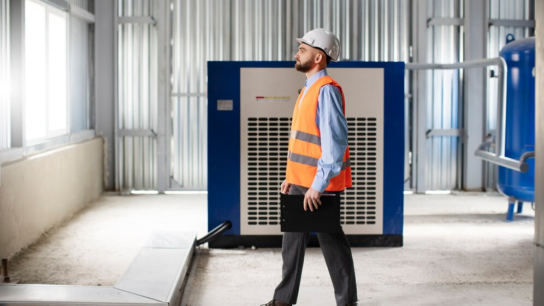Smart thermostats offer innovative solutions for managing home heating and cooling systems, providing energy savings, convenience, and personalized comfort. By upgrading to a smart thermostat, homeowners can optimize energy usage, reduce utility costs, and create a more comfortable living environment. In this guide, we’ll explore the benefits of installing smart thermostats for energy savings and efficiency, along with key considerations and tips for maximizing their performance.
Subtitles:
- Understanding Smart Thermostat Technology
- Benefits of Energy-Efficient Temperature Control
Understanding Smart Thermostat Technology
1. Remote Access and Control
One of the primary features of smart thermostats is their ability to be controlled remotely via mobile apps or web interfaces. This allows homeowners to adjust temperature settings, monitor energy usage, and schedule heating or cooling cycles from anywhere, providing convenience and flexibility.
Tips:
- Mobile Apps: Download the manufacturer’s app compatible with your smart thermostat to gain remote access and control. Ensure the app offers user-friendly interfaces and intuitive navigation.
- Wi-Fi Connectivity: Connect your smart thermostat to your home Wi-Fi network for seamless remote access and updates. Verify network compatibility and security settings for data protection.
- Voice Commands: Some smart thermostats support voice commands through virtual assistants like Amazon Alexa or Google Assistant, enabling hands-free control of temperature settings.
2. Learning and Adaptive Algorithms
Many smart thermostats feature learning algorithms that analyze user behavior, occupancy patterns, and environmental conditions to optimize temperature settings automatically. These adaptive algorithms adjust heating and cooling cycles based on preferences, occupancy, and energy-saving goals.
Tips:
- Initial Setup: Follow the manufacturer’s instructions for initial setup and configuration, including preferences for temperature ranges, schedules, and comfort settings.
- Adaptive Learning: Allow time for the smart thermostat to learn your habits and preferences. Provide feedback and adjustments as needed to fine-tune its performance.
- Occupancy Sensors: Utilize occupancy sensors or motion detectors if available to optimize energy usage based on room occupancy. Customize settings for different zones or areas of the home.
3. Energy Usage Tracking and Reports
Smart thermostats provide detailed energy usage data, reports, and insights to help homeowners monitor and analyze heating and cooling patterns. This information empowers users to make informed decisions, identify energy-saving opportunities, and adjust settings for efficiency.
Tips:
- Usage History: Review daily, weekly, or monthly energy usage reports provided by the smart thermostat. Identify trends, peak usage times, and potential areas for improvement.
- Energy-saving Tips: Use energy-saving tips and recommendations offered by the smart thermostat app or interface. Implement suggested changes to optimize energy efficiency without compromising comfort.
- Budget Tracking: Some smart thermostats offer budget tracking features that estimate energy costs based on usage patterns. Set budget goals and alerts to manage expenses effectively.
Benefits of Energy-Efficient Temperature Control
1. Cost Savings and Efficiency
Smart thermostats help reduce energy waste by optimizing temperature settings based on occupancy, preferences, and external factors such as weather conditions. This leads to lower utility bills, increased energy efficiency, and cost savings over time.
Tips:
- Temperature Scheduling: Create customized temperature schedules based on daily routines, occupancy patterns, and sleep schedules. Program setbacks or adjustments during periods of low activity or when occupants are away.
- Temperature Limits: Set temperature limits or boundaries to prevent excessive heating or cooling, ensuring comfort while maximizing energy savings. Use eco-friendly settings and energy-saving modes for extended periods of absence.
2. Comfort and Convenience
Smart thermostats offer personalized comfort settings tailored to individual preferences, ensuring optimal indoor conditions throughout the day. Features such as geofencing, vacation modes, and adaptive learning enhance comfort and convenience for occupants.
Tips:
- Geofencing: Use geofencing capabilities to detect occupants’ proximity to home and adjust temperature settings accordingly. This feature helps conserve energy when occupants are away and pre-condition the home for their return.
- Vacation Modes: Activate vacation or away modes when leaving for extended periods to minimize energy usage. Set temperature setbacks or energy-saving profiles to maintain safe and efficient heating or cooling.
- Custom Comfort Profiles: Create custom comfort profiles for different occupants or zones within the home. Fine-tune settings for bedrooms, living areas, and other spaces based on individual preferences.
3. Environmental Impact and Sustainability
By reducing energy consumption and optimizing heating and cooling cycles, smart thermostats contribute to environmental sustainability and reduced carbon footprint. Energy-efficient temperature control helps conserve natural resources and promotes eco-friendly practices.
Tips:
- Energy-saving Tips: Implement energy-saving tips and recommendations provided by the smart thermostat app or manufacturer. Adjust settings, upgrade insulation, and perform HVAC maintenance to further enhance efficiency.
- Integration with Smart Home Systems: Integrate smart thermostats with other smart home systems such as lighting, shades, and appliances for coordinated energy management. Use energy dashboards or reports to track overall home energy usage.
In conclusion, installing smart thermostats offers numerous benefits, including energy savings, cost efficiency, personalized comfort, and environmental sustainability. By understanding smart thermostat technology, utilizing energy-saving features, and optimizing temperature control, homeowners can create a more efficient and comfortable living environment while reducing their carbon footprint. Embracing smart technology for energy management is a step towards a greener and more sustainable future.








